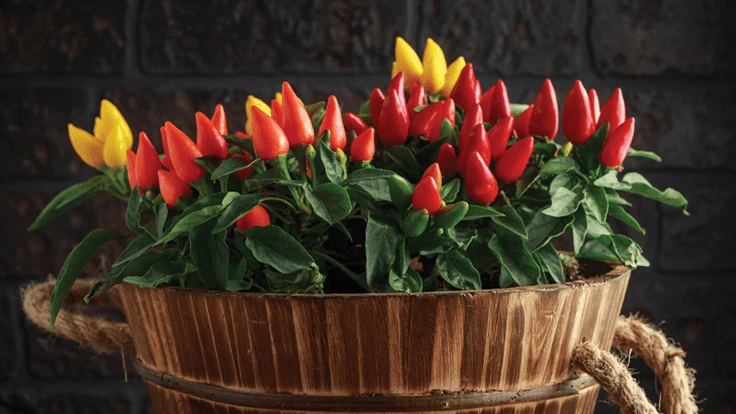

Ornamental hot peppers (Capsicum sp.) and their exciting use throughout the landscape are finally entering the lexicon of most gardeners. The contributions of colorful fruits in white, cream, yellow, orange, red, purple and black are significant, particularly later in the season as the fruits ripen up over the hot summer months. Many varieties will go through a colorful transition with multiple colors of fruiting on the same plant.
The ornamental impact of these increasingly vivid fruits can rival any bedding plant late in summer. Most ornamental hot peppers have some common traits which include shorter stature, fruits that are frequently staged and held above the foliage and, of course, the colorful fruiting show that is exceptional until the hardest of frost.
Why ornamental peppers?
It is important to note that while “ornamental hot peppers” are edible, they are not bred for culinary value and frequently lack the depth of taste that many traditional hot pepper varieties provide in terms of a flavor profile. Most ornamental hot peppers have muted taste, but a whole lot of heat.
With limited to no culinary history, most of the ornamental hot peppers haven’t been researched for Scoville heat units (SHU) that reflect the heat of these fruits. Be wary of the unknown. Keep in mind that some people have severe allergic reactions in relation to eating, handling or even being near hot peppers in the garden.
It is important to also note that some of our most common hot peppers (i.e. ‘Jalapeno’, ‘Tabasco’, ‘Scotch Bonnet’, etc.) are also beautiful when the fruits transition to more intense color as they ripen.
A feature of merit that is often overlooked in the category of ornamental hot peppers is the contribution of ornamental foliage. As with any type of plant, having multiple features of interest diversifies the ornamental contributions of the plant, adds additional or lengthier interest and in the case of ornamental foliage, may become the primary feature of interest.
With ornamental hot peppers becoming so popular in bedding schemes, container arrangements, later season displays and simply for general use, the contribution of ornamental foliage broadens the opportunity for using these plants in showy and imaginative combinations.
Here are a few of my favorite ornamental pepper varieties available today.

White/cream variegated ornamental hot peppers
I’m personally a big fan of variegation in any type of plant. While we might be selecting certain plants for interesting form, flowers, fall color, etc., having the additional contribution of variegation just adds to the extended show. That’s certainly the case with variegated ornamental hot peppers as well.
Some great selections with the white/cream contribution include Uchu (9 inches), ‘Sparkler’ (18 inches) and the classic selection ‘Fish’ (24 inches). It’s interesting to note that in some instances, the variegation extends to the fruits as well. This is the case with both ‘Sparkler’ and ‘Fish’. This variegation, while varying in prominence, is still visible throughout the color transition of the fruits. All of these selections have a fruiting transition from cream to yellow, orange and finally red with multiple colors on display depending on the maturity of separate fruits.
If you are interested in variegated sweet pepper selections, look for ‘Confetti’ or ‘Candy Cane Red’ which are both mini-bell selections with impressive variegation of foliage and fruits.

_fmt.png)
Violet/purple variegated ornamental hot peppers
For simply the sheer value of foliage contribution, these selections are excellent. I’ve grown ‘Purple Flash’ ornamental hot pepper for over 20 years and never tire of the reliable, variable, purple variegation seen throughout the foliage with no two leaves being identical.
Reaching 15 inches in height, this is truly a bedding plant known for prominent foliage as the fruits are jet-black, quite small and truly a secondary asset to the foliage.
The variety ‘Tricolor Variegata’ (18 inches) is another classic selection with similar splashes of purple and cream over the foliage. However, the thin, long fruits of this selection become more prominent as they transition from deep purple to bright red.
_fmt.png)
Ornamental hot peppers with darkening foliage
_fmt.png)
_fmt.png)
Dark foliage
My personal favorite ornamental hot pepper is the variety ‘Black Pearl’ which displays near-black foliage in full sun. The fruits emerge a glossy black and age to a bright red late in the season. This 2006 All-America Selections (AAS) winner reaches 24 inches in height and offers a rich, bold color with and without the fruiting contribution.
Additional AAS winners with black foliage and similar impact include ‘Black Olive’ (18 inches), ‘Black Hawk’ (12 inches) and Onyx Red (9 inches). All of these selections have the same colorful fruit transition from glossy black to bright red.
The variety ‘Count Dracula’ (16 inches) was another favorite with a black, matte-finish foliage contribution with short, elongated fruiting that also goes from black to red. Full sun is absolutely necessary to get the deepest black foliage coloration on all of these selections. Emerging foliage, while having hints of green, will all deepen and darken in full sun during the hot summer months.

_fmt.png)
_fmt.png)

Explore the July 2021 Issue
Check out more from this issue and find your next story to read.
Latest from Garden Center
- America in Bloom announces 2026 program launch and celebrates 25 years of growing vibrant communities
- AmericanHort launches HortCred to advance skills development in the green industry
- Oasis Grower Solutions announces new northeast territory sales manager
- Amanda Solliday named senior manager of Sustainabloom
- New McCarthy-Family Flowers Legacy Fund supports multi-generational retail florists
- Monrovia releases new retail program, Landscape Legends, to mark 100th anniversary
- USDA to conduct 2025 Organic Survey
- Save the date for the 78th Santa Barbara International Orchid Show





